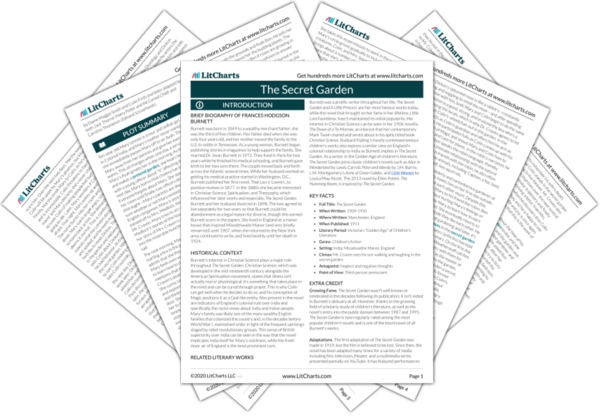Welcome to the LitCharts study guide on Frances Hodgson Burnett's The Secret Garden. Created by the original team behind SparkNotes, LitCharts are the world's best literature guides.
The Secret Garden: Introduction
The Secret Garden: Plot Summary
The Secret Garden: Detailed Summary & Analysis
The Secret Garden: Themes
The Secret Garden: Quotes
The Secret Garden: Characters
The Secret Garden: Terms
The Secret Garden: Symbols
The Secret Garden: Literary Devices
The Secret Garden: Quizzes
The Secret Garden: Theme Wheel
Brief Biography of Frances Hodgson Burnett

Historical Context of The Secret Garden
Other Books Related to The Secret Garden
Key Facts about The Secret Garden
- Full Title: The Secret Garden
- When Written: 1909-1910
- Where Written: Manchester, England
- When Published: 1911
- Literary Period: Victorian; "Golden Age" of Children's Literature
- Genre: Children's fiction
- Setting: India; Misselwaithe Manor, England
- Climax: Mr. Craven sees his son walking and laughing in the secret garden.
- Antagonist: Neglect and negative thoughts
- Point of View: Third-person omniscient
Extra Credit for The Secret Garden
Growing Fame. The Secret Garden wasn't well known or celebrated in the decades following its publication; it isn't noted in Burnett's obituary at all. However, thanks to the growing field of scholarly study of children's literature, as well as the novel's entry into the public domain between 1987 and 1995, The Secret Garden is now regularly rated among the most popular children's novels and is one of the best known of all Burnett's works.
Adaptations. The first adaptation of The Secret Garden was made in 1919, but the film is believed to be lost. Since then, the novel has been adapted many times for a variety of media including film, television, theater, and a multimedia series presented partially on YouTube. It has featured performances by Dame Maggie Smith and Colin Firth and been adapted by both Jack Thorne (Harry Potter and the Cursed Child) and Caroline Thompson (Edward Scissorhands).







